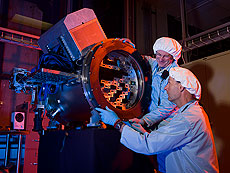Dark Energy Camera
 |
| Dark Energy Survey scientists work on a prototype of the Dark Energy Camera |
Editor's note: This is the first in an ongoing series of Experiment Profiles. Each profile will give an overview of an experiment at Fermilab or that Fermilab is involved in. These profiles will explain what scientists hope to learn, why the experiment is needed, what makes it unique and more. Please watch Fermilab Today for more experiment profiles.
NAME: The Dark Energy Survey, or DES, which uses the Dark Energy Camera, called DECam
WHAT WILL THIS TELL US? Because gravity causes mass to attract other mass, over time, this gravitational pull should slow the universe’s expansion. Instead, the universe is accelerating: Galaxies are speeding away from each other faster and faster. DES aims to help pin down the cause of this acceleration. Theorists offer two possibilities: Either three-quarters of the universe is dark energy, which causes a type of anti-gravity, or gravity itself behaves differently on cosmic scales than Einstein thought it did. The answer will determine the fate of the universe. If Einstein was correct, the expansion of the universe will continue to speed up, and in 100 billion years the observable universe will be almost empty of galaxies or will have ripped apart.
To find clues to the characteristics of dark energy, DES also will trace the history of the expanding universe roughly three-quarters of the way back to the time of the Big Bang. It will do this by measuring the distribution of galaxies throughout space, how the gravity of dark matter distorts their shapes, how galaxies cluster and the brightness of exploding stars called supernovae.
WHY IS THIS EXPERIMENT NEEDED NOW? Research during the last decade using different methods has confirmed that the expansion rate of the universe is speeding up. The next step is to understand why the expansion rate of the universe is accelerating---its physical cause. The answer is likely to change our understanding of the behavior of the natural forces, such as gravity, that cause everything in the world to interact.
WHAT IS DES LOOKING FOR? DES will survey about one-tenth of the sky, or 5,000 square degrees, to measure 300 million galaxies and carry out repeat surveys over a smaller portion of the sky to discover thousands of supernovae.
FUNDED BY: DOE, NSF, non-U.S. funding agencies and participating institutions
NUMBER OF COLLABORATORS: More than 120 scientists, plus students and postdocs
U.S. COLLABORATING INSTITUTIONS: Four national labs, eight universities, one national observatory
NON-US COLLABORATING INSTITUTIONS: 13 universities and research centers (Germany, Brazil, UK, Spain)
STATUS: Final construction and testing of DECam is underway; part shipments to Chile set for September 2010 through June 2011.
LIFESPAN OF EXPERIMENT: Starting in 2012 and continuing for five years.
Read more
|